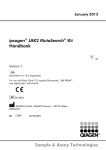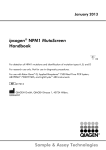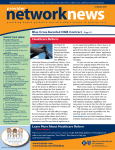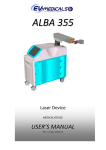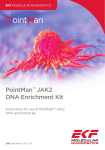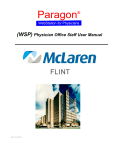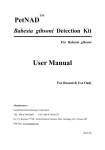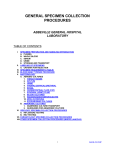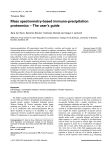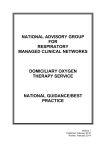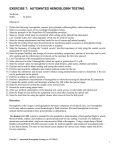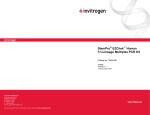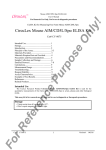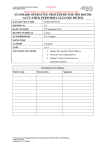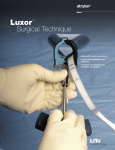Download Sample & Assay Technologies ipsogen® JAK2
Transcript
January 2013 ipsogen® JAK2 MutaScreen RS Kit Handbook 19 Version 1 Quantitative in vitro diagnostics For use with Rotor-Gene® Q, Applied Biosystems®, ABI PRISM®, and LightCycler® instruments 673123 QIAGEN GmbH, QIAGEN Strasse 1, 40724 Hilden, GERMANY R1 1072513EN Sample & Assay Technologies QIAGEN Sample and Assay Technologies QIAGEN is the leading provider of innovative sample and assay technologies, enabling the isolation and detection of contents of any biological sample. Our advanced, high-quality products and services ensure success from sample to result. QIAGEN sets standards in: Purification of DNA, RNA, and proteins Nucleic acid and protein assays microRNA research and RNAi Automation of sample and assay technologies Our mission is to enable you to achieve outstanding success and breakthroughs. For more information, visit www.qiagen.com. Contents Intended Use 4 Summary and Explanation 4 Principle of the Procedure 6 Materials Provided 8 Kit contents Materials Required but Not Provided Warnings and Precautions General precautions 8 9 10 10 Reagent Storage and Handling 11 Procedure 12 Sample DNA preparation 12 Storing nucleic acids 12 Protocols qPCR on Rotor Gene Q instruments with 72-tube rotor 12 qPCR on Applied Biosystems and ABI PRISM instruments 21 qPCR on the LightCycler 480 instrument 29 qPCR on LightCycler 2.0 instrument 36 Interpretation of Results 41 Graphical representation and quality control criteria 41 Calculation of normalized FAM/VIC ratio and genotyping 42 Troubleshooting guide 45 Quality Control 47 Limitations 47 Performance Characteristics 47 Nonclinical studies 47 Clinical studies 48 References 53 Symbols 54 Contact Information 54 Ordering Information 55 ipsogen JAK2 MutaScreen RS Kit Handbook 01/2013 3 Intended Use The ipsogen JAK2 MutaScreen RS Kit is intended for the detection of JAK2 V617F/G1849T mutation in genomic DNA from subjects with suspected myeloproliferative neoplasm. The absence of JAK2 V617F/G1849T does not exclude the presence of other JAK2 mutations. The test can report false negative results in case of additional mutations located in codons 615 to 619 (1). Note: The kit should be used following the instructions given in this manual, in combination with validated reagents and instruments. Any off-label use of this product and/or modification of the components will void QIAGEN’s liability. Summary and Explanation A recurrent somatic mutation, V617F, affecting the Janus tyrosine kinase 2 (JAK2) gene, has been identified in 2005 (2–5), leading to a major breakthrough in the understanding, classification, and diagnosis of myeloproliferative neoplasms (MPN). JAK2 is a critical intracellular signaling molecule for a number of cytokines, including erythropoietin. The JAK2 V617F mutation is detected in >95% of patients with polycythemia vera (PV), 50–60% of patients with essential thrombocythemia (ET), and in 50% of patients with primary myelofibrosis (PMF). JAK2 V617F has been also detected in some rare cases of chronic myelomonocytic leukemia, myelodysplasic syndrome, systemic mastocytosis, and chronic neutrophilic leukemia, but in 0% of CML (6). The mutation corresponds to a single-nucleotide change of JAK2 nucleotide 1849 in exon 14, resulting in a unique valine (V) to phenylalanine (F) substitution at position 617 of the protein (JH2 domain). It leads to constitutive activation of JAK2, hematopoietic transformation in vitro, and erythropoietinindependent erythroid colony (EEC) growth in all patients with PV and a large proportion of ET and PMF patients (7). JAK2 V617F represents a key driver in the transformation of hematopoietic cells in MPN, but the exact pathological mechanisms leading, with the same unique mutation, to such different clinical and biological entities remain to be fully elucidated. Traditionally, the diagnosis of MPNs was based on clinical, bone marrow histology and cytogenetic criteria. The discovery of a disease-specific molecular marker resulted in both simplification of the process and increased diagnostic accuracy. Detection of the JAK2 V617F mutation is now part of the reference WHO 2008 criteria for the diagnosis of BCR-ABL negative MPN (Table 1), and presence of this mutation is a major criterion for diagnostic confirmation. 4 ipsogen JAK2 MutaScreen RS Kit Handbook 01/2013 Table 1. WHO criteria for the diagnosis of MPN (adapted from reference 8) Criteria for a diagnosis of polycythemia vera (PV) Major 1. Hemoglobin (Hgb) >18.5 g.dl-1 (men) or >16.5 g.dl-1 (women) or Hgb or hematocrit (Hct) >99th percentile of reference range for age, sex, or altitude of residence or Hgb >17 g.dl-1 (men) or >15 g.dl-1 (women) if associated with sustained increase of ≥2 g.dl-1 from baseline that cannot be attributed to correction of iron deficiency or Elevated red cell mass >25% above mean normal predicted value 2. Presence of JAK2V617F or similar mutation Minor 1. Bone marrow trilineage myeloproliferation 2. Subnormal serum erythropoietin level 3. Endogenous erythroid colony (EEC) growth Criteria for a diagnosis of essential thrombocythemia (ET) Major 1. Platelet count ≥450 x 109 l-1 2. Megakaryocyte proliferation with large and mature morphology. No or little granulocyte or erythroid proliferation 3. Not meeting WHO criteria for chronic myeloid leukemia (CML), PV, primary myelofibrosis (PMF), myelodysplastic syndrome (MDS), or other myeloid neoplasm 4. Demonstration of JAK2V617F or other clonal marker or No evidence of reactive thrombocytosis Minor Criteria for a diagnosis of primary myelofibrosis (PMF) Major 1. Megakaryocyte proliferation and atypia accompanied by either reticulin and/or collagen fibrosis or In the absence of reticulin fibrosis, the megakaryocyte changes must be accompanied by increased marrow cellularity, granulocytic proliferation and often decreased erythropoiesis (i.e. prefibrotic PMF) 2. Not meeting WHO criteria for (CML), PV, MDS, or other myeloid neoplasm 3. Demonstration of JAK2V617F or other clonal marker or No evidence of reactive marrow fibrosis Minor 1. Leukoerythroblastosis 2. Increased serum lactate dehydrogenase (LDH) 3. Anemia 4. Palpable splenomegaly Recently, international experts have proposed criteria for therapeutic trials in PV and ET. Based on data on allograft, alpha-interferon, or hydroxyurea, JAK2V617F quantification has been incorporated as a potentially useful tool to monitor treatment response (9). A decrease in JAK2 V617F burden has been ipsogen JAK2 MutaScreen RS Kit Handbook 01/2013 5 observed in response to some of the new anti-JAK2 targeted drugs in clinical development (10). Principle of the Procedure In an allelic discrimination assay, two TaqMan® probes are used in a multiplexed assay. One is a perfect match to the allele 2 sequence (e.g., the wild-type allele), the other one is a perfect match to the allele 1 sequence (e.g., the allele with a mutation). Each probe is labeled with a distinctive fluorescent dye at its 5' end, the Reporter, such as FAM™ or VIC®, and contains a nonfluorescent Quencher at the 3' end. The probes also contain a minor grove binder (MGB™) permitting the use of shorter probes with greater stability and thereby a more accurate allelic discrimination. During the extension phase of the PCR, the perfectly matched probe is cleaved by the 5'→3' exonuclease activity of Taq polymerase, separating the Reporter dye from the Quencher and thus releasing detectable fluorescence. The probe not perfectly matched will be displaced rather than cleaved by the Taq polymerase and no reporter dye is released. The fluorescence signal (VIC or FAM) generated is collected at the end of the PCR (end-point) and immediately indicates the presence of the targeted sequence(s) in the sample (wild-type allele, mutated allele or both) without the requirement of long and laborious post-PCR steps, which also increase the contamination risk. The actual quantity of target sequence is not determined. The ipsogen JAK2 MutaScreen RS Kit uses this technology as illustrated (see Figure 1). 6 ipsogen JAK2 MutaScreen RS Kit Handbook 01/2013 Figure 1. TaqMan probe multiplex assay. The ipsogen JAK2 MutaScreen RS Kit uses this technology for allelic discrimination. ipsogen JAK2 MutaScreen RS Kit Handbook 01/2013 7 Materials Provided Kit contents (19) ipsogen JAK2 MutaScreen RS Kit Catalog no. 673123 Number of reactions 19 V617F Positive Control* MP-VF 30 μl V617F Negative Control† MN-VF 30 μl Reference Scale M1‡ M1-VF 30 μl Reference Scale M2‡ M2-VF 30 μl Reference Scale M3‡ M3-VF 30 μl Reference Scale M4‡ M4-VF 30 μl Reference Scale M5‡ M5-VF 30 μl Reference Scale M6‡ M6-VF 30 μl PPM-VF 10x 145 μl Primers and probes mix JAK2 V617F§ ipsogen JAK2 MutaScreen RS Kit Handbook (English) 1 * Positive control: 100% V617F DNA. † Negative control: 100% wild type DNA; 0% V617F DNA. ‡ Reference scale (genomic DNA dilutions). § Mix of specific reverse and forward primers for the JAK2 gene, specific V617F FAM probe and wild type VIC probe. Note: Briefly centrifuge tubes before use. Note: Analyzing unknown samples with the ipsogen JAK2 MutaScreen RS Kit requires the extraction of genomic DNA. Reagents needed to perform DNA extraction (e.g., QIAGEN® QIAamp® DNA Mini Kit, cat. no.51304) are not provided and must be validated in combination with the kit. 8 ipsogen JAK2 MutaScreen RS Kit Handbook 01/2013 Materials Required but Not Provided When working with chemicals, always wear a suitable lab coat, disposable gloves, and protective goggles. For more information, consult the appropriate safety data sheets (SDSs), available from the product supplier. Reagents Nuclease-free PCR grade water Nuclease-free 1x TE buffer, pH 8.0 (e.g., Life Technologies, cat. no. 12090-015) Buffer and Taq DNA polymerase: The validated reagents are TaqMan Universal PCR Master Mix (Master Mix PCR 2x) (Life Technologies, cat. no. 4304437) and LightCycler TaqMan Master (Master Mix PCR 5x) (Roche, cat. no. 04535286001) Reagents for 0.8–1% agarose gel in 0.5x TBE electrophoresis buffer Consumables Nuclease-free aerosol-resistant sterile PCR pipet tips with hydrophobic filters 0.5 ml or 0.2 ml RNase- and DNase-free PCR tubes Ice Equipment Microliter pipets* dedicated for PCR (1–10 μl; 10–100 μl; 100–1000 μl) Benchtop centrifuge* with rotor for 0.2 ml/0.5 ml reaction tubes (capable of attaining 10,000 rpm) Spectrophotometer* for DNA quantitation Real-time PCR instrument:* Rotor-Gene Q MDx 5plex HRM® or other Rotor-Gene instrument; LightCycler 2.0, or 480; Applied Biosystems 7300 Real-Time PCR System, Applied Biosystems 7500 Real-Time PCR System, ABI PRISM 7000 SDS, ABI PRISM 7700 SDS, or ABI PRISM 7900HT SDS; and associated specific material Equipment* for pulsed-field gel electrophoresis * Ensure that instruments have been checked and calibrated according to the manufacturer’s recommendations. ipsogen JAK2 MutaScreen RS Kit Handbook 01/2013 9 Warnings and Precautions For in vitro diagnostic use When working with chemicals, always wear a suitable lab coat, disposable gloves, and protective goggles. For more information, please consult the appropriate safety data sheets (SDSs). These are available online in convenient and compact PDF format at www.qiagen.com/safety where you can find, view, and print the SDS for each QIAGEN kit and kit component. Discard sample and assay waste according to your local safety regulations. 24-hour emergency information Emergency medical information in English, French, and German can be obtained 24 hours a day from: Poison Information Center Mainz, Germany Tel: +49-6131-19240 General precautions qPCR tests require good laboratory practices, including equipment maintenance, that are dedicated to molecular biology and compliant with applicable regulations and relevant standards. This kit is intended for in vitro diagnostic use. Reagents and instructions supplied in this kit have been validated for optimal performance. Further dilution of the reagents or alteration of incubation times and temperatures may result in erroneous or discordant data. PPM-VF reagent may be altered if exposed to light. All reagents are formulated specifically for use with this test. For optimal performance of the test, no substitutions should be made. Use extreme caution to prevent: DNase contamination which might cause degradation of the template DNA DNA or PCR carryover contamination resulting in false positive signal We therefore recommend the following. Use nuclease-free labware (e.g., pipets, pipet tips, reaction vials) and wear gloves when performing the assay. Use fresh aerosol-resistant pipet tips for all pipetting steps to avoid crosscontamination of the samples and reagents. Prepare pre-PCR master mix with dedicated material (pipets, tips, etc.) in a dedicated area where no DNA matrixes (DNA, plasmid) are introduced. Add template in a separate zone (preferably in a separate room) with specific material (pipets, tips, etc.). 10 ipsogen JAK2 MutaScreen RS Kit Handbook 01/2013 Reagent Storage and Handling The kits are shipped on dry ice and must be stored at –30°C to –15°C upon receipt. Minimize exposure to light of the primers and probe mixes (PPM-VF tube). Gently mix and centrifuge the tubes before opening. Store all kit components in original containers. These storage conditions apply to both opened and unopened components. Components stored under conditions other than those stated on the labels may not perform properly and may adversely affect the assay results. Expiration dates for each reagent are indicated on the individual component labels. Under correct storage conditions, the product will maintain performance until the expiration date printed on the label. There are no obvious signs to indicate instability of this product. However, positive and negative controls should be run simultaneously with unknown specimens. ipsogen JAK2 MutaScreen RS Kit Handbook 01/2013 11 Procedure Sample DNA preparation Genomic DNA should be obtained either from whole blood, purified peripheral blood lymphocytes, polynuclear cells, or granulocytes. To be able to compare results, we recommend adopting the same cellular fraction and DNA extraction method. DNA extraction should be performed by any home brew or commercial method. DNA quantity is determined by measuring optical density at 260 nm. DNA quality should be assessed by spectrophotometry or gel electrophoresis. The A260/A280 ratio should be 1.7–1.9. Smaller ratios usually indicate contamination by protein or organic chemicals. Electrophoretic analysis on a 0.8–1% agarose gel should allow visualization of the isolated DNA as a distinct band of about 20 kb. A slight smear is acceptable. The resultant DNA is diluted to 5 ng/μl in TE buffer. The qPCR reaction is optimized for 25 ng of purified genomic DNA. Storing nucleic acids For short-term storage of up to 24 hours, we recommend storing purified nucleic acids at 2–8°C. For long-term storage of over 24 hours, we recommend storage at –20°C. Protocol: qPCR on Rotor Gene Q instruments with 72-tube rotor Using this instrument, we recommend performing all measurements in duplicate, as indicated in Table 2. Table 2. Number of reactions for Rotor Gene Q MDx 5plex HRM or Rotor Gene Q 5plex HRM instruments with 72-tube rotor Samples Reactions JAK2 V617F primers and probes mix (PPM-VF) (56 reactions) 12 19 DNA samples 19 x 2 reactions 2 DNA controls 2 x 2 reactions (MP-VF, MN-VF, each one tested in duplicate) Reference scale 6 x 2 reactions (M1 to M6, each one tested in duplicate) Water control 2 reactions ipsogen JAK2 MutaScreen RS Kit Handbook 01/2013 Sample processing on Rotor-Gene Q instruments with 72-tube rotor Figure 2. Suggested rotor setup for an experiment with the ipsogen JAK2 MutaScreen RS Kit. MP-VF: positive control; MN-VF: negative control; M1 to M6: reference scale; S: DNA sample; H2O: water control. Note: Take care to always place a sample to be tested in position 1 of the rotor. Otherwise, during the calibration step, the instrument will not perform calibration, and incorrect fluorescence data will be acquired. Fill all other positions with empty tubes. qPCR on Rotor-Gene Q instruments with 72-tube rotor Note: Perform all steps on ice. Procedure 1. Thaw all necessary components and place them on ice. Components should be taken out of the freezer approximately 10 minutes before starting the procedure. ipsogen JAK2 MutaScreen RS Kit Handbook 01/2013 13 2. Vortex and briefly centrifuge all the tubes (approximately 10 seconds, 10,000 rpm, to collect the liquid in the bottom of the tube). 3. Prepare the following qPCR mix according to the number of samples being processed. All concentrations are for the final volume of the reaction. Table 3 describes the pipetting scheme for the preparation of one reagent mix, calculated to achieve a final reaction volume of 25 μl. A pre-mix can be prepared, according to the number of reactions, using the same primer and probe mix. Extra volumes are included to compensate for pipetting error. On Rotor-Gene instruments, the ipsogen JAK2 MutaScreen RS Kit can be used for analysis of 19 samples in duplicate in one experiment (Figure 2). Table 3. Preparation of qPCR mix Number of reactions (μl) 1 56+1* Final concentration TaqMan Universal PCR Master Mix, 2x 12.5 712.5 1x Primers and probes mix, 10x 2.5 142.5 1x Nuclease-free PCR grade water 5 285 – Sample (to be added at step 4) 5 5 each – Total volume 25 25 each – Component * 19 samples; 1 experiment/kit. 4. Vortex and briefly centrifuge the qPCR mix (approximately 10 seconds, 10,000 rpm, to collect the liquid in the bottom of the tube). 5. Dispense 20 μl of the qPCR pre-mix per tube. 6. Add 5 μl of the sample DNA material or controls in the corresponding tube (total volume 25 μl). 7. Mix gently, by pipetting up and down. 14 ipsogen JAK2 MutaScreen RS Kit Handbook 01/2013 8. Close the PCR tubes. Place the tubes in the 72-tube rotor according to the manufacturer’s recommendations. Fill all other positions with empty tubes. 9. Make sure that the locking ring (accessory of the Rotor-Gene Instrument) is placed on top of the rotor to prevent accidental opening of the tubes during the run. Place the rotor in the Rotor-Gene Q instrument according to the manufacturer’s recommendations. 10. For the detection of JAK2 DNA, create a temperature profile according to the following steps. Setting the general assay parameters Figures 3, 4 Amplification of the DNA Figure 5 Adjusting the fluorescence channel sensitivity Figure 6 Please find further information on programming Rotor-Gene Instruments in the instrument user manual. In the illustrations, the software settings are framed in bold black. Illustrations are included for Rotor-Gene Q Instruments. 11. Start the Rotor-Gene Software. In the “New Run” dialog box, click “New”. 1 Figure 3. The “New Run” dialog box. ipsogen JAK2 MutaScreen RS Kit Handbook 01/2013 15 12. In the “New Run Wizard”, set the volume to 25 μl and click “Next”. 1 2 Figure 4. Setting the general assay parameters. 13. Click the “Edit Profile” button in the next “New Run Wizard” dialog box, and program the temperature profile as shown in Table 4 and Figure 5. Be sure to add the last acquiring step at 60°C, at each cycle, for both channels Green (FAM) and Yellow (VIC). Table 4. Temperature profile Hold Temperature: 50 deg Time: 2 mins Hold 2 Temperature: 95 deg Time: 10 mins Cycling 50 times 92 deg for 15 secs 60 deg for 1 min; single Acquisition of FAM fluorescence in channel Cycling A Green Acquisition of VIC fluorescence in channel Cycling A Yellow 16 ipsogen JAK2 MutaScreen RS Kit Handbook 01/2013 1 2 5 6 3 4 Figure 5. Amplification of the DNA. 7 14. The detection range of the fluorescence channels has to be determined according to the fluorescence intensities in the PCR tubes. Click “Gain Optimisation” in the “New Run Wizard” dialog box to open the “Auto-Gain Optimisation Setup” dialog box. Click “Optimise Acquiring” (Figure 6), and then click “OK” in the “AutoGain Optimisation Channel Settings” dialog boxes for each channel (Green and Yellow, Figure 6). Make sure that the “Perform Optimisation Before 1st Acquisition” box is checked for each channel (Figure 6). 1 3 2 Figure 6. Adjusting the fluorescence channel sensitivity. 15. The gain values determined by the channel calibration are saved automatically and are listed in the last menu window of the programming procedure. Click “Start Run” to run the program. 16. Enter the rotor setup in the Rotor-Gene software (Figure 7). ipsogen JAK2 MutaScreen RS Kit Handbook 01/2013 17 Figure 7. Rotor-Gene setup: “Edit Samples”. End point analysis procedure for Rotor-Gene Q 5plex HRM instrument setting 17. After the PCR program has ended, click “Analysis” in the toolbar (Figure 8). Figure 8. Analysis. 18. In the “Analysis” dialog box (Figure 9), double-click “Cycling A Green”, and then “OK”. Repeat for Cycling A yellow. 18 ipsogen JAK2 MutaScreen RS Kit Handbook 01/2013 1 2 Figure 9. Quantitation: “Cycling A. Green”. 19. A new window appears (Figure 10). Click “Slope Correct” in both panels, as shown in Figure 10. 2 1 Figure 10. Setting “Slope Correct”. 20. To export data, save as an Excel® data sheet. Click “OK”, give a name to the export file, and save the text file (*.txt). 21. Open the text file in Excel and select column A. Click “Data”, then “Convert”, and “Next”. Select “Comma” and then click “End”. The results will appear as shown in Figure 11. ipsogen JAK2 MutaScreen RS Kit Handbook 01/2013 19 Figure 11. Example of results, shown in Excel file. Note: The file contains both raw data and standardized data. Only standardized data must be considered. These data are given in the Quantitative analysis of channel Cycling A Green and Quantitative analysis of channel Cycling A Yellow sections of the table. The data intended for interpretation are those acquired at PCR cycle 50 (in circles on the right). 20 ipsogen JAK2 MutaScreen RS Kit Handbook 01/2013 Protocol: qPCR on Applied Biosystems and ABI PRISM instruments Using 96 wells plate qPCR equipment, we recommend performing all measurements in duplicate as indicated in Table 5. Table 5. Number of reactions for Applied Biosystems 7300 and 7500, ABI PRISM 7000, ABI PRISM 7700, or ABI PRISM 7900HT instruments Samples Reactions JAK2 V617F primers and probes mix (PPM-VF) (56 reactions) 19 DNA samples 19 x 2 reactions 2 DNA controls 2 x 2 reactions (MP-VF, MN-VF, each one tested in duplicate) Reference scale 6 x 2 reactions (M1 to M6, each one tested in duplicate) Water control 2 reactions Sample processing on Applied Biosystems 7300 and 7500, ABI PRISM 7000 and 7700, or ABI PRISM 7900HT instruments Figure 12. Suggested plate setup for an experiment with the ipsogen JAK2 MutaScreen RS Kit. MP: positive control; MN: negative control; M1 to M6: reference scale; S: DNA sample; H2O: water control. ipsogen JAK2 MutaScreen RS Kit Handbook 01/2013 21 qPCR on Applied Biosystems 7300 and 7500, ABI PRISM 7000, ABI PRISM 7700, or ABI PRISM 7900HT instruments Note: Perform all steps on ice. Procedure 1. Thaw all necessary components and place them on ice. Components should be taken out of the freezer approximately 10 minutes before starting the procedure. 2. Vortex and briefly centrifuge all the tubes (approximately 10 seconds, 10,000 rpm, to collect the liquid in the bottom of the tube). 3. Prepare the following qPCR mix according to the number of samples being processed. All concentrations are for the final volume of the reaction. Table 6 describes the pipetting scheme for the preparation of one reagent mix, calculated to achieve a final reaction volume of 25 μl. A pre-mix can be prepared, according to the number of reactions, using the same primer and probe mix. Extra volumes are included to compensate for pipetting error. On the Applied Biosystems 7300 and 7500, ABI PRISM 7000, ABI PRISM 7700, or ABI PRISM 7900HT instruments, the ipsogen JAK2 MutaScreen RS Kit can be used for analysis of 19 samples in duplicate in one experiment (Figure 12). Table 6. Preparation of qPCR mix Number of reactions (μl) 1 56+1* Final concentration TaqMan Universal PCR Master Mix, 2x 12.5 712.5 1x Primers and probes mix, 10x 2.5 142.5 1x Nuclease-free PCR grade water 5 285 – Sample (to be added at step 4) 5 5 each – Total volume 25 25 each – Component * 19 samples; 1 experiment/kit. 22 ipsogen JAK2 MutaScreen RS Kit Handbook 01/2013 4. Vortex and briefly centrifuge the qPCR mix (approximately 10 seconds, 10,000 rpm, to collect the liquid in the bottom of the tube). 5. Dispense 20 μl of the qPCR pre-mix per well. 6. Add 5 μl of the sample DNA material or controls in the corresponding well (total volume 25 μl). 7. Mix gently, by pipetting up and down. 8. Close the plate and briefly centrifuge (300 x g, approximately 10 seconds). 9. Place the plate in the thermal cycler according to the manufacturer’s recommendations. 10. Program the thermal cycler with the thermal cycling program as indicated in Table 7, and start the run. Table 7. Temperature profile for Applied Biosystems and ABI PRISM instruments Hold Temperature: 50°C Time: 2 minutes Hold 2 Temperature: 95°C Time: 10 minutes Cycling 50 times 92°C for 15 seconds 60°C for 1 minute Post-read run analysis procedure for Applied Biosystems and ABI PRISM instruments For programming details of the Applied Biosystems 7300 and 7500, ABI PRISM 7000, ABI PRISM 7700, or ABI PRISM 7900HT instruments, refer to the instrument user guide. For a better overview, the software settings are framed in bold black. 11. After the run is finished, select “Start/Program”, and then select “File/New”. 12. In the “New Document Wizard” dialog box, click the “Assay” dropdown list, and select “Allelic Discrimination” (Figure 13). 13. Accept the default settings for the “Container” and “Template” fields (“96-Well Clear” and “Blank Document”, Figure 13). In the “Plate ipsogen JAK2 MutaScreen RS Kit Handbook 01/2013 23 Name” field, type AD Post-read (Figure 13), and then click “Next>” to access the “Select Markers” dialog box. 1 2 3 4 Figure 13. Pre-settings for creating a new post-read run (New Document Wizard). 14. If the “Markers in Document” panel in the “Select Markers” dialog box contains a suitable marker for your application, proceed with step 18. If not, then continue with step 15. 15. Create detectors and markers as follows. Click “New Detector” (Figure 14). 1 Figure 14. The “Markers in Document” panel does not contain a suitable marker for your application. 24 ipsogen JAK2 MutaScreen RS Kit Handbook 01/2013 16. In the “New Detector” dialog box, type Allele A in the “Name” field (Figure 15). Leave the “Reporter Dye” set to “FAM”. Click the “Color” button, select a color, and then click “OK” (Figure 15). Click “Create Another” (Figure 15). 1 2 3 4 Figure 15. Creating detectors. 17. In the next “New Detector” dialog box, type Allele B in the “Name” field. Select “VIC” in the “Reporter Dye” field. Click the “Color” button, select a color, and then click “OK”. 18. Click “New Marker” in the “Select Markers” dialog box (see Figure 14). 19. In the “New Marker” dialog box, type JAK2 in the “New Marker Name” field (Figure 16). Select the “Allele A” and “Allele B” detectors as created in steps 16 and 17 (or already defined), and click “OK” (Figure 16). 1 2 3 Figure 16. Creating markers. ipsogen JAK2 MutaScreen RS Kit Handbook 01/2013 25 20. In the “Select Markers” dialog box, select “JAK2”, as created above, or a suitable predefined marker, and then click “Add>>” (Figure 17). Note: To remove a marker, select it and then click “Remove”. 1 2 3 Figure 17. Selecting markers. 21. Click “Next>”. 22. In the “Setup Sample Plate” dialog box, click and drag to select the marker for wells that contain samples. Click “Finish”. 23. Select the “Instrument” tab, and change the sample volume to 25 μl. 24. Select “File/Save” and then click “Save” to retain the name you assigned when you created the plate. 25. Load the reaction plate into the instrument according to the manufacturer’s recommendations 26 ipsogen JAK2 MutaScreen RS Kit Handbook 01/2013 26. Start the post-read run. Click “Post-Read”. The instrument will perform a run of 1 cycle for 60 seconds at 60°C. During this run, the instrument collects FAM and VIC fluorescence in each well (Figure 18). Figure 18. Post-read run. ipsogen JAK2 MutaScreen RS Kit Handbook 01/2013 27 27. Select “File/Export” and then click “Results” to export the results to an Excel file. The results will appear as shown in Figure 19. Figure 19. Example of results, shown in an Excel file. 28 ipsogen JAK2 MutaScreen RS Kit Handbook 01/2013 Protocol: qPCR on the LightCycler 480 instrument Using 96-well plate qPCR equipment, we recommend performing all measurements in duplicate as indicated in Table 8. Table 8. Number of reactions for the LightCycler 480 instrument Samples Reactions JAK2 V617F primers and probes mix (PPM-VF) (56 reactions) 19 DNA samples 19 x 2 reactions 2 DNA controls 2 x 2 reactions (MP-VF, MN-VF, each one tested in duplicate) Reference scale 6 x 2 reactions (M1 to M6, each one tested in duplicate) Water control 2 reactions Sample processing on the LightCycler 480 instrument Figure 20. Suggested plate setup for an experiment with the ipsogen JAK2 MutaScreen RS Kit. MP: positive control; MN: negative control; M1 to M6: reference scale; S: DNA sample; H2O: water control. ipsogen JAK2 MutaScreen RS Kit Handbook 01/2013 29 qPCR on the LightCycler 480 instrument Note: Perform all steps on ice. Procedure 1. Thaw all necessary components and place them on ice. Components should be taken out of the freezer approximately 10 minutes before starting the procedure. 2. Vortex and briefly centrifuge all the tubes (approximately 10 seconds, 10,000 rpm, to collect the liquid in the bottom of the tube). 3. Prepare the following qPCR mix according to the number of samples being processed. All concentrations are for the final volume of the reaction. Table 9 describes the pipetting scheme for the preparation of one reagent mix, calculated to achieve a final reaction volume of 25 μl. A pre-mix can be prepared, according to the number of reactions, using the same primer and probe mix. Extra volumes are included to compensate for pipetting error. On the Applied Biosystems 7300 and 7500, ABI PRISM 7000, ABI PRISM 7700, or ABI PRISM 7900HT instruments, the ipsogen JAK2 MutaScreen RS Kit can be used for analysis of 19 samples in duplicate in one experiment (Figure 20). Table 9. Preparation of qPCR mix Number of reactions (μl) 1 56+1* Final concentration TaqMan Universal PCR Master Mix, 2x 12.5 712.5 1x Primers and probes mix, 10x 2.5 142.5 1x Nuclease-free PCR grade water 5 285 – Sample (to be added at step 4) 5 5 each – Total volume 25 25 each – Component * 19 samples; 1 experiment/kit. 30 ipsogen JAK2 MutaScreen RS Kit Handbook 01/2013 4. Vortex and briefly centrifuge the qPCR mix (approximately 10 seconds, 10,000 rpm, to collect the liquid in the bottom of the tube). 5. Dispense 20 μl of the qPCR pre-mix per well. 6. Add 5 μl of the sample DNA material or controls in the corresponding well (total volume 25 μl). 7. Mix gently, by pipetting up and down. 8. Close the plate and briefly centrifuge (300 x g, approximately 10 seconds). 9. Place the plate in the thermal cycler according to the manufacturer’s recommendations. 10. On the home page, select “New Experiment”. 11. For the LightCycler 480 I, follow step 11a. For the LightCycler 480 II, follow step 11b. For programming details of the LightCycler 480 instrument, refer to the instrument user guide. For a better overview, the software settings are framed in bold black. 11a. LightCycler 480 I: Select “Multi Color Hydrolysis Probe”, click “Customize”, and then check that the channels “FAM (483–533)” and “Hex (533–568)” (i.e., VIC) are selected (Figure 21). Set the reaction volume to “25” μl (Figure 21) and proceed with step 12. 2 4 1 3 Figure 21. LightCycler 480 I: Setting the detection format. ipsogen JAK2 MutaScreen RS Kit Handbook 01/2013 31 11b. LightCycler 480 II: Select “Dual Color Hydrolysis Probe”, click “Customize”, and then check that the channels“ FAM (465–510)” and “VIC / HEX / (533–580)” are selected (Figure 22). Set the reaction volume to “25” μl (Figure 22) and proceed with step 12. 2 4 1 3 Figure 22. LightCycler 480 II: Setting the detection format. 32 ipsogen JAK2 MutaScreen RS Kit Handbook 01/2013 12. Program the thermal cycler with the thermal cycling program as indicated in Table 10, and start the run. Note: When describing the plate setup on the instrument, select “Endpt Geno” in the “Step 1 : select workflow” section. Table 10. Temperature profile for the LightCycler 480 instrument Hold Temperature: 50°C Time: 2 minutes Hold 2 Temperature: 95°C Time: 10 minutes Cycling 50 times 92°C for 15 seconds; single 60°C for 1 minute; single Hold 3 60°C for 1 minute; single End-point analysis procedure for the LightCycler 480 instrument 13. After the run is finished, click “Analysis”. 14. In the “Create New Analysis” dialog box, select “Endpoint Genotyping”, and then select the subset to analyze in the “Subset” menu (Figure 23). 2 1 Figure 23. Selecting analysis type and subset to analyze. ipsogen JAK2 MutaScreen RS Kit Handbook 01/2013 33 15. In the next window, select “Hex” (i.e., VIC) fluorescence for “Allele X” and “FAM” fluorescence for “Allele Y” (Figure 24). 1 2 Figure 24. Selecting fluorescence for “Allele X” and “Allele Y”. 16. The next window (Figure 25) shows plate setup (1, upper left), fluorescence results for each sample (2, bottom left), and the scatter plot with allelic discrimination (3, right; FAM and VIC fluorescence measured at the 50th PCR cycle). 1 3 2 Figure 25. Data summary. 17. To export data, right-click on the sample results template, and then select “Export Table”. The file will be saved in a text (.txt) file format. 34 ipsogen JAK2 MutaScreen RS Kit Handbook 01/2013 18. To view and analyze results, open the file using Excel. The results will appear as shown in Figure 26. VIC FAM Figure 26. Example of results, shown in an Excel file. ipsogen JAK2 MutaScreen RS Kit Handbook 01/2013 35 Protocol: qPCR on LightCycler 2.0 instrument Note: Because of particular technological requirements, LightCycler 2.0 experiments must be performed using specific reagents. We recommend the use of the LightCycler TaqMan Master. Follow the manufacturer’s instructions to prepare the Master Mix 5x. Using a 32-capillary rotor, we recommend performing all measurements in duplicate as indicated in Table 11. Table 11. Number of reactions for LightCycler 2.0 instrument Samples Reactions JAK2 V617F primers and probes mix (PPM-VF) (32 reactions) 7 DNA samples 7 x 2 reactions 2 DNA controls 2 x 2 reactions (MP-VF, MN-VF, each one tested in duplicate) Reference scale 6 x 2 reactions (M1 to M6, each one tested in duplicate) Water control 2 reactions Sample processing on LightCycler 2.0 instrument Figure 27. Suggested rotor setup for an experiment with the ipsogen JAK2 MutaScreen RS Kit. MP: positive control; MN: negative control; M1 to M6: reference scale; S: DNA sample; H2O: water control. 36 ipsogen JAK2 MutaScreen RS Kit Handbook 01/2013 qPCR on LightCycler 2.0 instrument Note: Perform all steps on ice. Procedure 1. Thaw all necessary components and place them on ice. Components should be taken out of the freezer approximately 10 minutes before starting the procedure. 2. Vortex and briefly centrifuge all the tubes (approximately 10 seconds, 10,000 rpm, to collect the liquid in the bottom of the tube). 3. Prepare the following qPCR mix according to the number of samples being processed. All concentrations are for the final volume of the reaction. Table 12 describes the pipetting scheme for the preparation of one reagent mix, calculated to achieve a final reaction volume of 20 μl. A pre-mix can be prepared, according to the number of reactions, using the same primer and probe mix. Extra volumes are included to compensate for pipetting error. On the LightCycler 2.0 instrument, the ipsogen JAK2 MutaScreen RS Kit can be used for analysis of 7 samples in duplicate in one experiment (Figure 27). Table 12. Preparation of qPCR mix for LightCycler 2.0 instrument Number of reactions (μl) Component 1 32+1* Final concentration LightCycler TaqMan Master Mix, 5x 4 132 1x Primers and probes mix, 10x 2 66 1x Nuclease-free PCR grade water 9 297 – Sample (to be added at step 4) 5 5 each – Total volume 20 20 each – * 14 samples; 2 experiments/kit. ipsogen JAK2 MutaScreen RS Kit Handbook 01/2013 37 4. Vortex and briefly centrifuge the qPCR mix (approximately 10 seconds, 10,000 rpm, to collect the liquid in the bottom of the tube). 5. Dispense 15 μl of the qPCR pre-mix per capillary. 6. Add 5 μl of the sample DNA material or controls in the corresponding capillary (total volume 20 μl). 7. Mix gently, by pipetting up and down. 8. Place the capillaries in the adapter provided with the instrument and briefly centrifuge (700 x g, approximately 10 seconds). 9. Load the samples in the thermal cycler according to the manufacturer’s recommendations. 10. Program the thermal cycler (Figure 28) with the program as indicated in Table 13. For programming details of the LightCycler 2.0 instrument, refer to the instrument user guide. For a better overview, the software settings are framed in bold black. Note: Make sure that the setting is for Quantification and single acquisition of FAM fluorescence and single acquisition of VIC fluorescence in both the amplification/cycling step and the final hold at 60°C. 1 2 Figure 28. Programming screen for LightCycler 2.0. 38 ipsogen JAK2 MutaScreen RS Kit Handbook 01/2013 Table 13. Temperature profile for LightCycler 2.0 instrument Hold Temperature: 55°C Time: 2 minutes Ramp: 20 Hold 2 Temperature: 95°C Time: 10 minutes Ramp: 20 Cycling 50 times 92°C for 15 seconds; ramp: 20 60°C for 1 minute; ramp 20 Hold 3 60°C for 1 minute; ramp 20 End-point analysis procedure for LightCycler 2.0 instrument 11. At the end of the amplification run, click the tab for “Online Data Display” (Figure 29). Open the display menu on the top left of the “Current Fluorescence” window, then write 51 in “Acquisition no.” . 1 2 Figure 29. Results and history in Online Data Display. 12. Right-click near the “Current Fluorescence” graph and select “Export”. ipsogen JAK2 MutaScreen RS Kit Handbook 01/2013 39 13. Click the “Excel” box on the “Export chart” dialog box (Figure 30). Enter a name in the “Filename” dialog field. Select an export destination for the result file with the button. Click “Export”. 1 3 4 2 Figure 30. Selecting the export format and data file destination. 14. To view and analyze results, open the file in Excel. The results for LightCycler 2.0 will appear as shown. Figure 31. Example of LightCycler 2.0 results, shown in an Excel file. 40 ipsogen JAK2 MutaScreen RS Kit Handbook 01/2013 Interpretation of Results Obtain a file suitable to extract exported data for all instruments: Rotor-Gene Q MDx 5plex HRM or other Rotor-Gene instrument, LightCycler 2.0, or 480; Applied Biosystems 7300 or 7500 Real-Time PCR System, ABI PRISM 7000 SDS, 7700 SDS, or 7900HT SDS, and check the fluorescence levels (these must be consistent between duplicates). Prepare a graphical representation (scatter plot) of fluorescence data. The x axis is VIC fluorescence; the y axis is FAM fluorescence. Graphical representation and quality control criteria An example of a scatter plot is shown in Figure 32. Figure 32. Scatter plot of a representative allelic discrimination experiment. Instruments: Rotor-Gene Q, Applied Biosystems, ABI PRISM, and LightCycler 480. Samples should be located on the arc connecting the negative controls (MN) to the positive controls (MP). Improper positioning of any control may indicate an experimental error. Positive controls should be located in the upper left. Negative controls should be located in the bottom right. Poor positioning of a negative control may indicate contamination. The cut-off sample (M1 of the reference scale) should appear above the negative controls. Water controls should be located at the bottom left. ipsogen JAK2 MutaScreen RS Kit Handbook 01/2013 41 Poor positioning of a water control (higher than MN for FAM measurement or higher than MP for VIC) may indicate contamination. Note: Positioning of the controls may be different on analysis of LightCycler 2.0 instrument data (see Figure 33). The water controls should still be located at the bottom left. Figure 33. Scatter plot of a representative allelic discrimination experiment. Instrument: LightCycler 2.0. Calculation of normalized FAM/VIC ratio and genotyping Calculate the FAM/VIC ratios for all the samples. Calculate the FAM/VIC ratios for the positive control (MP), the cut-off sample (M1), the negative control (MN), and the reference scale (M2 to M6). The ratios must be consistent between duplicates. Calculate the average ratio of all duplicates. Calculate the normalized ratio (NRatio) for the cut-off sample (M1) and for all the samples: NRatioSample = RatioSample RatioMN Note: The gray zone (GZ) of a test is defined as an area of values where the discriminatory performance is insufficiently accurate. A value in the gray zone indicates that the target marker cannot be scored as either present or absent. The gray zone must be calculated for each experiment. 42 ipsogen JAK2 MutaScreen RS Kit Handbook 01/2013 Calculate the gray zone, or the incertitude area, around the normalized ratio of the cut-off sample (M1) (NRatioM1): GZ: [(NRatioM1 x 0.94); (NRatioM1 x1.06)] Compare the Normalized Ratio of each sample to the NRatioM1 GZ. Interpretation of results is outlined in Table 14. Table 14. Interpretation of genotyping results using normalized ratios Results Interpretation NRatioSample > NRatioM1 x 1.06 JAK2 V617F is detected NRatioSample < NRatioM1 x 0.94 JAK2 V617F is not detected NRatioSample within NRatioM1 GZ Result inconclusive A semiquantitative result for the mutation burden can be obtained by comparing the value of each unknown sample ratio (RatioSample) with the mean ratio values of the reference scale (RatioM1–6) (see Table 15). Table 15. Semiquantitative values for the JAK2 V617F mutation burden using the reference scale Results Mutation burden RatioM1< RatioSample < RatioM2 2–5% JAK2 V617F RatioM2< RatioSample < RatioM3 5–12.5% JAK2 V617F RatioM3< RatioSample < RatioM4 12.5–31% JAK2 V617F RatioM4< RatioSample < RatioM5 31–50% JAK2 V617F RatioM5< RatioSample < RatioM6 50–78% JAK2 V617F RatioM6< RatioSample 78–100% JAK2 V617F An example of data calculation and interpretation is given in Table 16. ipsogen JAK2 MutaScreen RS Kit Handbook 01/2013 43 Table 16. An example of fluorescence data calculation and interpretation using the reference scale 44 Sample VIC FAM Ratio MN 49.613 3.8 0.077 MN 49.797 3.976 0.08 MP 12.516 37.037 2.959 MP 12.958 38.121 2.942 M1 54.394 6.39 0.117 M1 58.266 6.973 0.12 M2 61.798 10.882 0.176 M2 54.814 9.231 0.168 M3 57.364 16.604 0.289 M3 59.742 18.192 0.305 M4 56.965 28.99 0.509 M4 58.077 29.158 0.502 M5 54.251 37.221 0.686 M5 54.979 36.125 0.657 M6 46.185 44.498 0.963 M6 45.077 42.598 0.945 S1 13.47 37.409 2.777 S1 14.559 42.616 2.927 S2 50.432 24.958 0.495 S2 53.797 27.746 0.516 S3 52.038 5.995 0.115 S3 54.01 6.364 0.118 S4 50.811 4.842 0.095 S4 0.01 – 0 GZ 1.425 1.607 Mean ratio NRatio Interpretation 0.078 1.000 Mutation not detected 2.951 37.722 Mutation detected 0.119 1.516 Cut-off sample 0.172 2.202 Mutation detected 0.297 3.797 Mutation detected 0.505 6.462 Mutation detected 0.672 8.586 Mutation detected 0.954 12.2 Mutation detected 2.852 36.464 Mutation (78–100%) 0.505 6.46 Mutation (12.5–31%) 0.117 1.49 Inconclusive result 0.048 0.609 Inconclusive result ipsogen JAK2 MutaScreen RS Kit Handbook 01/2013 Troubleshooting guide This troubleshooting guide may be helpful in solving any problems that may arise. For more information, see also the Frequently Asked Questions page at our Technical Support Center: www.qiagen.com/FAQ/FAQList.aspx. The scientists in QIAGEN Technical Services are always happy to answer any questions you may have about either the information and protocols in this handbook or sample and assay technologies (for contact information, see “Contact Information”, page 54). Comments and suggestions Positive control signal negative a) Pipetting error Check pipetting scheme and the setup of the reaction. Repeat the PCR run. b) Inappropriate storage of kit components Store the ipsogen JAK2 MutaScreen RS Kit at – 30 to –15°C and keep primers and probes mix (PPM) protected from light. See “Reagent Storage and Handling”, page 11. Avoid repeated freezing and thawing. Aliquot reagents for storage. Negative controls are positive Cross-contamination Replace all critical reagents. Repeat the experiment with new aliquots of all reagents. Always handle samples, kit components, and consumables in accordance with commonly accepted practices to prevent carry-over contamination. No signal, even in positive controls a) Pipetting error or omitted reagents Check pipetting scheme and the setup of the reaction. Repeat the PCR run. b) Inhibitory effects of the sample material, caused by insufficient purification Repeat the DNA preparation. ipsogen JAK2 MutaScreen RS Kit Handbook 01/2013 45 Comments and suggestions c) LightCycler: Incorrect detection channel chosen Set Channel Setting to F1/F2 or 530 nm/640 nm. d) LightCycler: No data acquisition programmed Check the cycle programs. Select acquisition mode “single” at the end of each annealing segment of the PCR program. Absent or low signal in samples but positive controls okay Poor DNA quality or low concentration Always check the DNA quality and concentration before starting. LightCycler: Fluorescence intensity too low a) Inappropriate storage of kit components Store the ipsogen JAK2 MutaScreen RS Kit at –30 to –15°C and keep primers and probes mix (PPM) protected from light. See “Reagent Storage and Handling”, page 11. Avoid repeated freezing and thawing. Aliquot reagents for storage. b) Very low initial amount of target DNA Increase the amount of sample DNA. Note: Depending of the chosen method of DNA preparation, inhibitory effects may occur. LightCycler: Fluorescence intensity varies a) Pipetting error Variability caused by so-called “pipetting error” can be reduced by analyzing data in the F1/F2 or 530 nm/640 nm mode. b) Insufficient centrifugation of the capillaries The prepared PCR mix may still be in the upper vessel of the capillary, or an air bubble could be trapped in the capillary tip. Always centrifuge capillaries loaded with the reaction mix as described in the specific operating manual of the apparatus. c) Outer surface of the capillary tip dirty 46 Always wear gloves when handling the capillaries. ipsogen JAK2 MutaScreen RS Kit Handbook 01/2013 Quality Control Quality control of the complete kit has been performed on a LightCycler 480.This kit is manufactured according to ISO 13485:2003 standard. Certificates of Analysis are available upon request at www.qiagen.com/support/. Limitations The users must be trained and familiar with this technology prior to the use of this device. This kit should be used following the instructions given in this manual, in combination with a validated instrument mentioned in “Materials Required but Not Provided”, page 9. Any diagnostic results that are generated must be interpreted in conjunction with other clinical or laboratory findings. It is the user’s responsibility to validate system performance for any procedures used in their laboratory which are not covered by the QIAGEN performance studies. Attention should be paid to expiration dates printed on the box and labels of all components. Do not use expired components. Performance Characteristics Nonclinical studies Nonclinical studies were conducted to establish the analytical performance of the ipsogen JAK2 MutaScreen Kit. Precision Three dilution levels of genomic DNA from cell lines harboring the JAK2 V617F mutation in wild type DNA were tested. The dilutions corresponded to mutation loads of 1%, 2%, and 3%. Independent dilution batches were obtained for each level, and replicates of these dilutions were tested in 3 independent experiments. Ratios obtained for each DNA sample (RatioSample) were compared with the negative control ratio (JAK2 100% wild type DNA, RatioNC). Results are summarized in Table 17. Table 17. Precision data for nonclinical studies. Mutation level RatioSample>RatioNC %CV (ratio) 1% V617F DNA 100% (n = 183) 6.8 2% V617F DNA 100% (n = 72) 4.5 3% V617F DNA 100% (n = 135) 5.1 ipsogen JAK2 MutaScreen RS Kit Handbook 01/2013 47 Interlaboratory analytical data A multi-center study was performed involving 13 laboratories. Analytical data were collected on dilutions of genomic DNA harboring JAK2 V617F mutation in wild type DNA. Three experiments were performed in each laboratory. For each experiment, the following DNA samples were tested from cell lines: 1 negative control (NC) 0% V617F 1 positive control (PC) 100% V617F 1 cut-off sample (COS) 2% V617F 3 samples harboring intermediate mutation loads (20%, 50%, and 80%) The experiments were performed on 7 different instrument models: ABI PRISM 7000 SDS (11), Applied Biosystems 7300 Real-Time PCR System (1), Applied Biosystems 7500 Real-Time PCR System (3), ABI PRISM 7700 SDS (11), ABI PRISM 7900 SDS (1), LightCycler 2.0 (1), and iCycler® (1). Results are summarized in Table 18. Table 18. Interlaboratory analytical data obtained from dilutions of genomic DNA from cell lines harboring the JAK2 V617F mutation in wild type DNA Sample detection Positive samples Negative samples JAK2 V617F 177* 0 JAK2 wild type 0 36 * Positive samples included 36 positive controls (PC), 36 cut-off samples (COS; 2% V617F), 34 samples harboring 20% JAK2 V617F, 35 samples harboring 50% JAK2 V617F, and 36 samples harboring 80% JAK2 V617F. Clinical studies Comparison between ipsogen JAK2 MutaScreen Kit and ARMS® method DNA samples from 141 patients with suspected MPN were tested in parallel with the ipsogen JAK2 MutaScreen Kit and a qPCR assay based on the amplification refractory mutation system (ARMS) principle (5). Results of the comparison are shown in Table 19 (2 x 3 contingency table) and Table 20 (percentage agreement). 48 ipsogen JAK2 MutaScreen RS Kit Handbook 01/2013 Table 19. Comparison between methods: ipsogen JAK2 MutaScreen Kit and ARMS Results of ARMS testing method Results of ipsogen JAK2 MutaScreen testing method JAK2 V617F >2% JAK2 V617F <2% Total 91 0 91 Inconclusive 1 result 2 3 JAK2 WT No mutation 1 detected 46 47 48 n = 141 JAK2 V617F Mutation detected Total 93 Table 20. Comparison between methods: ipsogen JAK2 MutaScreen Kit and ARMS Agreement (%) 95% CI* (%) Positive data Agreement between ipsogen JAK2 MutaScreen Kit and ARMS 98.9 94.1–99.8 Negative data Agreement between ipsogen JAK2 MutaScreen Kit and ARMS 100 92.3–100 Total agreement 99.3 96.0–99.9 * Confidence intervals were calculated according to CLSI EP12-A “User Protocol for Evaluation of Qualitative Test Performance; Approved Guideline”. Comparison between ipsogen JAK2 MutaScreen Kit and sequencing DNA samples from 51 patients with suspected MPN were tested in parallel with the ipsogen JAK2 MutaScreen Kit and the reference technique (“gold standard”), direct sequencing. One sample could not be interpreted due to sequencing failure. Comparisons of results obtained from the 50 interpretable samples are summarized in Table 21 (2 x 3 contingency table) and Table 22 (percentage agreement). ipsogen JAK2 MutaScreen RS Kit Handbook 01/2013 49 Table 21. Comparison between methods: ipsogen JAK2 MutaScreen Kit and sequencing Results of direct sequencing Results of ipsogen JAK2 MutaScreen testing method JAK2 V617F >2% JAK2 V617F <2% Total 26 1 27 Inconclusive 0 result 1 1 JAK2 WT No mutation 2 detected 20 22 22 n = 50 JAK2 V617F Mutation detected Total 28 Table 22. Comparison between methods: ipsogen JAK2 MutaScreen Kit and sequencing Agreement (%) 95% CI* (%) Positive data Agreement between ipsogen JAK2 MutaScreen Kit and sequencing 92.9 77.4–98.0 Negative data Agreement between ipsogen JAK2 MutaScreen Kit and sequencing 95.2 77.3–99.2 Total agreement 93.9 83.5–97.9 * Confidence intervals were calculated according to CLSI EP12-A “User Protocol for Evaluation of Qualitative Test Performance; Approved Guideline”. Multicenter study on 228 patient samples DNA samples from patients were analyzed with home brew techniques in 13 laboratories contributing to an interlaboratory study. In each laboratory, 3 experiments were performed, using DNA from cell lines as described for the nonclinical precision data (see above), and with DNA from 10 patients available in the laboratory. 50 ipsogen JAK2 MutaScreen RS Kit Handbook 01/2013 The 228 samples with a known JAK2 genotype were tested in parallel with the ipsogen JAK2 MutaScreen Kit and by home brew methods, including qualitative PCR, allele specific PCR, fluorescence energy resonance transfer (FRET), sequencing, allele specific oligonucleotide PCR, RFLP, and allelic discrimination. Results of the comparisons are shown in Table 23 (2 x 3 contingency table) and Table 24 (percentage agreement). Table 23. Comparison between methods: ipsogen JAK2 MutaScreen Kit and home brew methods Results of home brew testing Results of ipsogen JAK2 MutaScreen testing method JAK2 V617F >2% JAK2 V617F <2% Total 139 3 142 Inconclusive 5 result 17 22 JAK2 WT No mutation 3 detected 61 64 81 n = 228 JAK2 V617F Mutation detected Total 147 Table 24. Comparison between methods: JAK2 MutaScreen Kit and home brew methods Agreement (%) 95% CI* (%) Positive data Agreement between ipsogen JAK2 MutaScreen Kit and home brew 97.9 94.0–99.3 Negative data Agreement between ipsogen JAK2 MutaScreen Kit and home brew 95.3 87.1–98.4 Total agreement 97.1 93.8–98.7 * Confidence intervals were calculated according to CLSI EP12-A “User Protocol for Evaluation of Qualitative Test Performance; Approved Guideline”. ipsogen JAK2 MutaScreen RS Kit Handbook 01/2013 51 Robustness: testing of samples from healthy donors DNA samples from103 healthy blood-donors were analyzed with the ipsogen JAK2 MutaScreen RS Kit. All of the samples were detected as JAK2 wild-type. Analysis of 38 samples with the LightCycler 480 instrument is shown in Figure 34. Figure 34. Analysis of healthy donors. LightCycler 480 analysis of 38 healthy donors () with the ipsogen JAK2 MutaScreen RS Kit (cat. no. 673123). Positive results in duplicate () correspond to a reference scale supplied with the kit. VIC fluorescence values are plotted on the x axis and FAM values are plotted on the y axis. 52 ipsogen JAK2 MutaScreen RS Kit Handbook 01/2013 References QIAGEN maintains a large, up-to-date online database of scientific publications utilizing QIAGEN products. Comprehensive search options allow you to find the articles you need, either by a simple keyword search or by specifying the application, research area, title, etc. For a complete list of references, visit the QIAGEN Reference Database online at www.qiagen.com/RefDB/search.asp or contact QIAGEN Technical Services or your local distributor. Cited references 1. Ma, W. et al. (2009) Mutation profile of JAK2 transcripts in patients with chronic myeloproliferative neoplasias. J. Mol. Diagn. 11, 49. 2. James, C. et al. (2005) A unique clonal JAK2 mutation leading to constitutive signalling causes polycythaemia vera. Nature 434, 1144. 3. Levine, R.L. et al. (2005) Activating mutation in the tyrosine kinase JAK2 in polycythemia vera, essential thrombocythemia, and myeloid metaplasia with myelofibrosis. Cancer Cell 7, 387. 4. Kralovics, R. et al. (2005) A gain-of-function mutation of JAK2 in myeloproliferative disorders. N. Engl. J. Med. 352, 1779. 5. Baxter, E.J. et al. (2005) Acquired mutation of the tyrosine kinase JAK2 in human myeloproliferative disorders. Lancet 36, 1054. 6. Tefferi, A. et al. (2009) Myeloproliferative neoplasms: contemporary diagnosis using histology and genetics. Nat. Rev. Clin. Oncol. 6, 627. 7. Prchal, J.F. and Axelrad, A.A. (1974) Bone marrow responses in polycythemia vera. N. Engl. J. Med. 290, 1382. 8. Tefferi, A. and Vardiman, J.W. (2008) Classification and diagnosis of myeloproliferative neoplasms: the 2008 World Health Organization criteria and point-of-care diagnostic algorithms. Leukemia 22, 14. 9. Barosi, G. et al. (2009) Response criteria for essential thrombocythemia and polycythemia vera: result of a European LeukemiaNet consensus conference. Blood 113, 4829. 10. Pardanani, A. et al. (2011) Safety and efficacy of TG101348, a selective JAK2 inhibitor, in myelofibrosis. J. Clin. Oncol. 29, 789. 11. Lippert, E. et al. (2006) The JAK2-V617F mutation is frequently present at diagnosis in patients with essential thrombocythemia and polycythemia vera. Blood 108, 1865. ipsogen JAK2 MutaScreen RS Kit Handbook 01/2013 53 Symbols The following symbols may appear on the packaging and labeling: <N> Contains reagents sufficient for <N> reactions Use by In vitro diagnostic medical device Catalog number Lot number Material number Temperature limitation Manufacturer Consult instructions for use Contact Information For technical assistance and more information, please see our Technical Support Center at www.qiagen.com/Support, call 00800-22-44-6000, or contact one of the QIAGEN Technical Service Departments or local distributors (see back cover or visit www.qiagen.com). 54 ipsogen JAK2 MutaScreen RS Kit Handbook 01/2013 Ordering Information Product Contents Cat. no. ipsogen JAK2 MutaScreen RS Kit (19) For 19 reactions: V617F Positive Control, V617F Negative Control, V617F Reference Scale, Primers and Probes Mix JAK2 wild type and JAK2 V617F 673123 Rotor-Gene Q MDx — for IVD-validated real-time PCR analysis in clinical applications Rotor-Gene Q MDx 5plex HRM Platform Real-time PCR cycler and High Resolution Melt analyzer with 5 channels (green, yellow, orange, red, crimson) plus HRM channel, laptop computer, software, accessories, 1-year warranty on parts and labor, installation and training not included 9002032 Rotor-Gene Q MDx 5plex HRM System Real-time PCR cycler and High Resolution Melt analyzer with 5 channels (green, yellow, orange, red, crimson) plus HRM channel, laptop computer, software, accessories, 1-year warranty on parts and labor, installation and training 9002033 For up-to-date licensing information and product-specific disclaimers, see the respective QIAGEN kit handbook or user manual. QIAGEN kit handbooks and user manuals are available at www.qiagen.com or can be requested from QIAGEN Technical Services or your local distributor. ipsogen JAK2 MutaScreen RS Kit Handbook 01/2013 55 This page intentionally left blank 56 ipsogen JAK2 MutaScreen RS Kit Handbook 01/2013 This page intentionally left blank ipsogen JAK2 MutaScreen RS Kit Handbook 01/2013 57 This page intentionally left blank 58 ipsogen JAK2 MutaScreen RS Kit Handbook 01/2013 This product is intended for in vitro diagnostic use. ipsogen products may not be resold, modified for resale or used to manufacture commercial products without written approval of QIAGEN. Information in this document is subject to change without notice. QIAGEN assumes no responsibility for any errors that may appear in this document. This document is believed to be complete and accurate at the time of publication. In no event shall QIAGEN be liable for incidental, special, multiple, or consequential damages in connection with, or arising from the use of this document. ipsogen products are warranted to meet their stated specifications. QIAGEN’s sole obligation and the customer's sole remedy are limited to replacement of products free of charge in the event products fail to perform as warranted. This product is sold under a licensing arrangement with Epoch Biosciences for use only in in vitro diagnostics, and may not be used for any other research, commercial, clinical research, or other use outside of the in vitro diagnostics field. JAK2 V617F mutation and uses thereof are protected by patent rights, including European patent EP1692281, US patents 7,429,456 and 7,781,199, US patent applications US20090162849 and US20120066776, and foreign counterparts. The purchase of this product does not convey any right for its use for clinical trials for JAK2 V617F targeted drugs. QIAGEN develops specific license programs for such uses. Please contact our legal department at [email protected]. Trademarks: QIAGEN®, QIAamp®, HRM®, ipsogen®, Rotor-Gene® (QIAGEN Group); ABI PRISM®, Applied Biosystems®, FAM™, VIC® (Life Technologies); ARMS® (AstraZeneca Ltd.); Excel® (Microsoft Corporation); iCycler® (Bio-Rad Laboratories, Inc.); LightCycler®, TaqMan® (Roche Group); MGB™ (Epoch Biosciences). Limited License Agreement Use of this product signifies the agreement of any purchaser or user of the ipsogen JAK2 MutaScreen RS Kit to the following terms: 1. The ipsogenJAK2 MutaScreen RS Kit may be used solely in accordance with the ipsogen JAK2 MutaScreen RS Kit Handbook and for use with components contained in the Kit only. QIAGEN grants no license under any of its intellectual property to use or incorporate the enclosed components of this Kit with any components not included within this Kit except as described in the ipsogen JAK2 MutaScreen RS Kit Handbook and additional protocols available at www.qiagen.com. 2. Other than expressly stated licenses, QIAGEN makes no warranty that this Kit and/or its use(s) do not infringe the rights of third-parties. 3. This Kit and its components are licensed for one-time use and may not be reused, refurbished, or resold. 4. QIAGEN specifically disclaims any other licenses, expressed or implied other than those expressly stated. 5. The purchaser and user of the Kit agree not to take or permit anyone else to take any steps that could lead to or facilitate any acts prohibited above. QIAGEN may enforce the prohibitions of this Limited License Agreement in any Court, and shall recover all its investigative and Court costs, including attorney fees, in any action to enforce this Limited License Agreement or any of its intellectual property rights relating to the Kit and/or its components. For updated license terms, see www.qiagen.com. © 2013 QIAGEN, all rights reserved. www.qiagen.com Australia [email protected] Austria [email protected] Belgium [email protected] Brazil [email protected] Canada [email protected] China [email protected] Denmark [email protected] Finland [email protected] France [email protected] Germany [email protected] Hong Kong [email protected] India [email protected] Ireland [email protected] Italy [email protected] Japan [email protected] Korea (South) [email protected] Luxembourg [email protected] Mexico [email protected] The Netherlands [email protected] Norway [email protected] Singapore [email protected] Sweden [email protected] Switzerland [email protected] UK [email protected] USA [email protected] 1072513 142329166 Sample & Assay Technologies




























































